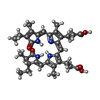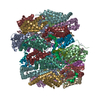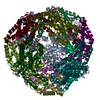+Search query
-Structure paper
| Title | Structural and quantum chemical basis for OCP-mediated quenching of phycobilisomes. |
|---|---|
| Journal, issue, pages | Sci Adv, Vol. 10, Issue 14, Page eadk7535, Year 2024 |
| Publish date | Apr 5, 2024 |
 Authors Authors | Paul V Sauer / Lorenzo Cupellini / Markus Sutter / Mattia Bondanza / María Agustina Domínguez Martin / Henning Kirst / David Bína / Adrian Fujiet Koh / Abhay Kotecha / Basil J Greber / Eva Nogales / Tomáš Polívka / Benedetta Mennucci / Cheryl A Kerfeld /      |
| PubMed Abstract | Cyanobacteria use large antenna complexes called phycobilisomes (PBSs) for light harvesting. However, intense light triggers non-photochemical quenching, where the orange carotenoid protein (OCP) ...Cyanobacteria use large antenna complexes called phycobilisomes (PBSs) for light harvesting. However, intense light triggers non-photochemical quenching, where the orange carotenoid protein (OCP) binds to PBS, dissipating excess energy as heat. The mechanism of efficiently transferring energy from phycocyanobilins in PBS to canthaxanthin in OCP remains insufficiently understood. Using cryo-electron microscopy, we unveiled the OCP-PBS complex structure at 1.6- to 2.1-angstrom resolution, showcasing its inherent flexibility. Using multiscale quantum chemistry, we disclosed the quenching mechanism. Identifying key protein residues, we clarified how canthaxanthin's transition dipole moment in its lowest-energy dark state becomes large enough for efficient energy transfer from phycocyanobilins. Our energy transfer model offers a detailed understanding of the atomic determinants of light harvesting regulation and antenna architecture in cyanobacteria. |
 External links External links |  Sci Adv / Sci Adv /  PubMed:38578996 / PubMed:38578996 /  PubMed Central PubMed Central |
| Methods | EM (single particle) |
| Resolution | 1.63 - 2.2 Å |
| Structure data | EMDB-41434, PDB-8to2: EMDB-41435, PDB-8to5:  EMDB-41436: Central rod disk in D3 symmetry of high-resolution phycobilisome quenched by OCP (local refinement)  EMDB-41463: Synechocystis PCC 6803 Phycobilisome quenched by OCP, high resolution EMDB-41475, PDB-8tpj: EMDB-41585, PDB-8tro: |
| Chemicals |  ChemComp-CYC:  ChemComp-45D:  ChemComp-HOH: |
| Source |
|
 Keywords Keywords | PHOTOSYNTHESIS / Complex / light harvesting / pigment |
 Movie
Movie Controller
Controller Structure viewers
Structure viewers About Yorodumi Papers
About Yorodumi Papers












